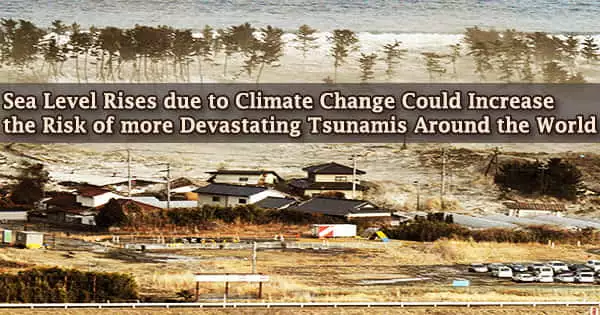According to a recent study led by Virginia Tech, as sea levels rise owing to climate change, so do global dangers and the potential for disastrous tsunami destruction. Even a modest change in sea level, as little as a foot, increases the risk of tsunamis for coastal cities around the world.
The threat of rising sea levels to coastal towns and people around the world is well known, but new results reveal that tsunamis following earthquakes are likely to cause floods further inland. Consider the tsunami that wreaked havoc on a section of northern Japan following the 2011 Tohoku-Oki earthquake, forcing a nuclear power facility to melt down and spread radioactive contaminants.
These findings are the focus of a new Science Advances study led by a multi-university team of scientists from the Singapore Earth Observatory, Nanyang Technological University’s Asian School of the Environment, and National Taiwan University, with critical support from Virginia Tech’s Robert Weiss, an associate professor in the College of Science’s Department of Geosciences.
“Our research shows that sea-level rise can significantly increase the tsunami hazard, which means that smaller tsunamis in the future can have the same adverse impacts as big tsunamis would today,” Weiss said, adding that smaller tsunamis generated by earthquakes with smaller magnitudes occur frequently and regularly around the world. For the study, Weiss was critical in helping create computational models and data analytics frameworks.
Weiss is the director of the National Science Foundation-funded Disaster Resilience and Risk Management graduate education program at Virginia Tech, as well as the co-leader of Coastal@VT, a group of 45 Virginia Tech faculty from 13 departments working on currents and emerging coastal zone issues like disaster resilience, migration, sensitive ecosystems, hazard assessment, and natural infrastructure.
The South China Sea is an excellent starting point for such a study because it is an ocean with rapid sea-level rise and also the location of many mega cities with significant worldwide consequences if impacted. The study is the first if its kind on the level of detail, and many will follow our example.
Robert Weiss
Weiss and his colleagues at the Earth Observatory of Singapore, including Lin Lin Li, a senior research fellow, and Adam Switzer, an associate professor, developed computer-simulated tsunamis in the Chinese region of Macau at present sea level and with sea-level increases of 1.5 feet and 3 feet.
Macau is a highly populated coastal location in South China that is now free of tsunami threats. An earthquake with a magnitude greater than 8.8 would be required to induce widespread tsunami inundation in Macau at the current sea level.
The crew was taken aback by the findings of the simulated sea-level hikes. The frequency of tsunami-induced flooding rose considerably with sea-level rise, from 1.2 to 2.4 times for a 1.5-foot rise and from 1.5 to 4.7 times for a 3-foot rise.
“We found that the increased inundation frequency was contributed by earthquakes of smaller magnitudes, which posed no threat at current sea level, but could cause significant inundation at higher sea-level conditions,” Li said.
In the simulated study of Macau population 613,000, Switzer said, “We produced a series of tsunami inundation maps for Macau using more than 5,000 tsunami simulations generated from synthetic earthquakes prepared for the Manila Trench.”
According to a team of US-Chinese scientists, sea levels in the Macau region are expected to rise 1.5 feet by 2060 and 3 feet by 2100.
The Manila Trench, a megathrust structure that runs from offshore Luzon in the Philippines to southern Taiwan, is the primary source of major tsunami risk in the South China Sea region. Since the 1560s, no earthquake larger than magnitude 7.8 has struck the Manila Trench megathrust.
However, research co-author Wang Yu of National Taiwan University noted that the region had many of the features of the source locations that resulted in the 2004 Sumatra-Andaman earthquake and the 2011 earthquake in northern Japan, both of which resulted in large casualties.
These increasing tsunami risks add to the already well-known challenges facing coastal populations around the world: the steady loss of land directly adjacent to coasts, as well as greater flooding risks even during high tides, as sea levels rise as the Earth warms.
“The South China Sea is an excellent starting point for such a study because it is an ocean with rapid sea-level rise and also the location of many mega cities with significant worldwide consequences if impacted. The study is the first if its kind on the level of detail, and many will follow our example,” Weiss said.
To construct or insure safer beaches, policymakers, town planners, emergency services, and insurance companies must collaborate, according to Weiss.
“Sea-level rise needs to be taken into account for planning purposes, for example for reclamation efforts but also for designing protective measures, such as seawalls or green infrastructure.”
He added, “What we assumed to be the absolute worst case a few years ago now appears to be modest for what is predicted in some locations. We need to study local sea-level change more comprehensively in order to create better predictive models that help to make investments in infrastructure that are or near sustainable.”





